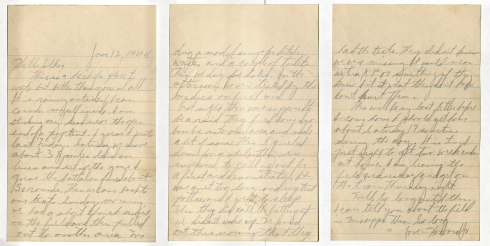As the University Archivist, I frequently hear from loyal Iowa Staters from across the country who inquire about donating materials to the University Archives. Often people are trying to find an appreciative home for some Iowa State memorabilia or seeing if there is any interest in a future donation of materials. This past fall I received a call from an Iowa State alum and former ISU professor regarding a small collection of materials in his possession that he was ready to part with.

Howard P. Johnson, three-time graduate of Iowa State University (we were just a College at the time he received his degrees) and former Professor and Head of ISU’s Agricultural and Biosystems Engineering Department, was contacting me regarding some World War II letters that he had. Dr. Johnson explained that he grew up on a farm near Odebolt, Iowa, and in 1943 was inducted into the military like many young men at that time. He served as a technician in the 69th Infantry Division and entered the war in Europe at the end of the Battle of the Bulge in January 1945. All during his military training and his service in Europe, young Pfc. Johnson wrote to his family back home in western Iowa–often several times a week–and his family wrote back. Howard would describe his daily routine, the duties he was assigned during training, and his experiences in Europe. His parents and siblings would respond with stories of family and community events, activities on the farm, and, of course, the weather.

As Dr. Johnson was explaining this to me over the phone, he questioned whether anyone would be interested in this collection of letters–nearly 400 in total. Although I recognized that these letters would not hold the same meaning to others as they do to him, I assured Dr. Johnson that people will certainly be interested in reading these letters for generations to come.

It is not every day that I am privileged to speak with a World War II veteran, nor is it often that such a complete collection of letters with so many connections to Iowa State and rural life in Iowa are offered to the department, so I was thrilled to accept the donation. The Johnson family letters offer an intimate snapshot of one Iowa farm family’s experience during a major turning point in American history. Similar stories played out thousands of times across the state and the country, but relatively few of those stories are so well documented.
Today, as we mark the 73rd anniversary of the D-Day landings in France, it is important to reflect upon those men and women who bravely served in World War II. Some names, like Eisenhower and MacArthur, will forever be associated with winning the war for the Allies. There are many more thousands of names, names like Howard P. Johnson, whose contributions are often overlooked. At least in this case his story will be preserved in the archives.
The Johnson family World War II letters are part of the Howard P. Johnson papers, RS 9/7/15, located in the Iowa State University Library Special Collections and University Archives. The department is open to researchers from 9am-5pm, Monday through Friday. Part of our mission is to preserve the history of Iowa State University and the stories of its faculty, staff, and alumni. If you have questions about whether we are the right home for your Iowa State story, give us a call, we would love to hear from you.













